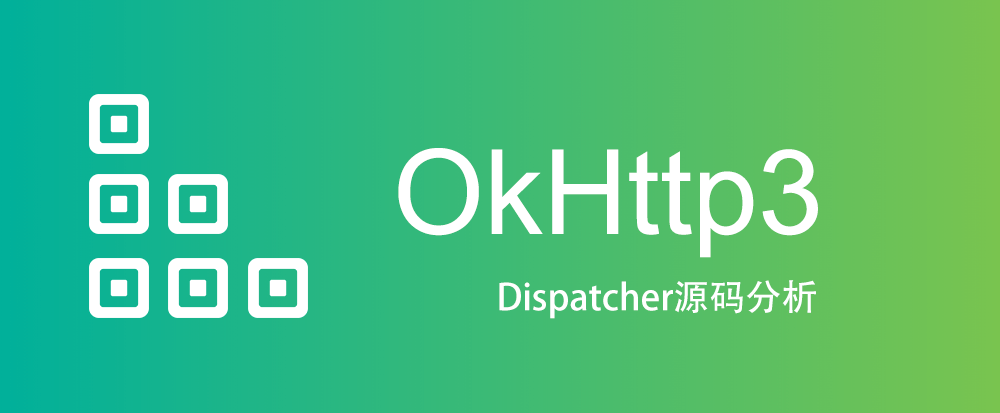OkHttp【四】任务调度Dispatcher
2017-12-26 小文字
前言
在发起HTTP请求后,OkHttp在RealCall封装的相关逻辑内执行了请求发起动作,而负责记录和调度Call的则是Dispatcher。
本文一起分析OkHttpClient#Dispatcher的相关实现。
/**
* Policy on when async requests are executed.
*
* <p>Each dispatcher uses an {@link ExecutorService} to run calls internally. If you supply your
* own executor, it should be able to run {@linkplain #getMaxRequests the configured maximum} number
* of calls concurrently.
*/
public final class Dispatcher {
// ...
}
任务调度
在构造OkHttpClient实例的时候,通过构造函数,创建了一个请求调度类Dispatcher。该类会在RealCall的异步请求接口enqueue和同步请求接口execute中被执行
client.dispatcher().executed(this);
client.dispatcher().enqueue(new AsyncCall(responseCallback));
先看下Dispatcher的内部主要接口和相关关系

可以看到,Dispatcher主要用于处理异步请求,同步请求只是简单加入了Deque。
并发限制
执行网络请求用的是Java并发包提供的API, 这里实例化一个ThreadPoolExecutor来处理多线程任务:
public synchronized ExecutorService executorService() {
if (executorService == null) {
executorService = new ThreadPoolExecutor(0, Integer.MAX_VALUE, 60, TimeUnit.SECONDS,
new SynchronousQueue<Runnable>(), Util.threadFactory("OkHttp Dispatcher", false));
}
return executorService;
}
从参数的选用上来看,上面的线程池声明也可以用并发包中newCachedThreadPool方法,配置上自身的ThreadFactory:
/**
* Creates a thread pool that creates new threads as needed, but
* will reuse previously constructed threads when they are
* available, and uses the provided
* ThreadFactory to create new threads when needed.
* @param threadFactory the factory to use when creating new threads
* @return the newly created thread pool
* @throws NullPointerException if threadFactory is null
*/
public static ExecutorService newCachedThreadPool(ThreadFactory threadFactory) {
return new ThreadPoolExecutor(0, Integer.MAX_VALUE,
60L, TimeUnit.SECONDS,
new SynchronousQueue<Runnable>(),
threadFactory);
}
根据ThreadPoolExecutor的定义,我们知道这里实例化了一个没有限制的无限队列来承载请求任务,按需创建/复用线程。无限制队列的特点就是,理论上提交的任务不断积累时,最终将耗尽内存。因此相对来说我们其实更常用的是有限队列,通过舍弃一些任务或者拒绝新增任务来保证机器不会耗尽内存。
/**
* Creates a new {@code ThreadPoolExecutor} with the given initial
* parameters and default rejected execution handler.
*
* @param corePoolSize the number of threads to keep in the pool, even
* if they are idle, unless {@code allowCoreThreadTimeOut} is set
* @param maximumPoolSize the maximum number of threads to allow in the
* pool
* @param keepAliveTime when the number of threads is greater than
* the core, this is the maximum time that excess idle threads
* will wait for new tasks before terminating.
* @param unit the time unit for the {@code keepAliveTime} argument
* @param workQueue the queue to use for holding tasks before they are
* executed. This queue will hold only the {@code Runnable}
* tasks submitted by the {@code execute} method.
* @param threadFactory the factory to use when the executor
* creates a new thread
* @throws IllegalArgumentException if one of the following holds:<br>
* {@code corePoolSize < 0}<br>
* {@code keepAliveTime < 0}<br>
* {@code maximumPoolSize <= 0}<br>
* {@code maximumPoolSize < corePoolSize}
* @throws NullPointerException if {@code workQueue}
* or {@code threadFactory} is null
*/
public ThreadPoolExecutor(int corePoolSize,
int maximumPoolSize,
long keepAliveTime,
TimeUnit unit,
BlockingQueue<Runnable> workQueue,
ThreadFactory threadFactory) {
this(corePoolSize, maximumPoolSize, keepAliveTime, unit, workQueue,
threadFactory, defaultHandler);
}
如果直接向原生上述ThreadPoolExecutor的提交10000个任务,并且每个任务休眠5秒钟来模拟耗时操作,那么很快就会发生OOM。
由于瞬间提交的任务数非常大,且每个任务都耗时,导致按需创建/复用线程的策略基本上无法复用已经实例化的线程。在为新任务实例化线程时需要大量内存,因此OOM就再说难免了。
那么OkHttp是这样处理的么?
在前面的UML中,看到Dispatcher有三个Deque来存放任务,通过控制maxRequests和maxRequestsPerHost来限制最大并发数,和相主机同域名下的并发数。
默认的最大并发数是64,同域名并发数是5,支持个性化配置。
所以这里通过多个Deque来缓存尚未获得执行的任务,以及正在执行的任务,实现并发任务的调度。
双队列缓存监测
还记得在RealCall中执行任务时调用的一些接口么?
client.dispatcher().finished(this);
在每个任务结束后,通过接口通知Dispatcher,再次检查任务队列,如果未触发最大并发数,则将新任务从等待队列已入执行队列。
/** Used by {@code AsyncCall#run} to signal completion. */
void finished(AsyncCall call) {
finished(runningAsyncCalls, call, true);
}
/** Used by {@code Call#execute} to signal completion. */
void finished(RealCall call) {
finished(runningSyncCalls, call, false);
}
private <T> void finished(Deque<T> calls, T call, boolean promoteCalls) {
int runningCallsCount;
Runnable idleCallback;
synchronized (this) {
if (!calls.remove(call)) throw new AssertionError("Call wasn't in-flight!");
if (promoteCalls) promoteCalls();
runningCallsCount = runningCallsCount();
idleCallback = this.idleCallback;
}
if (runningCallsCount == 0 && idleCallback != null) {
idleCallback.run();
}
}
具体移入操作由promoteCalls完成, 遍历readyAsyncCalls队列,加入runningAsyncCalls并提交给executorService:
private void promoteCalls() {
if (runningAsyncCalls.size() >= maxRequests) return; // Already running max capacity.
if (readyAsyncCalls.isEmpty()) return; // No ready calls to promote.
for (Iterator<AsyncCall> i = readyAsyncCalls.iterator(); i.hasNext(); ) {
AsyncCall call = i.next();
if (runningCallsForHost(call) < maxRequestsPerHost) {
i.remove();
runningAsyncCalls.add(call);
executorService().execute(call);
}
if (runningAsyncCalls.size() >= maxRequests) return; // Reached max capacity.
}
}